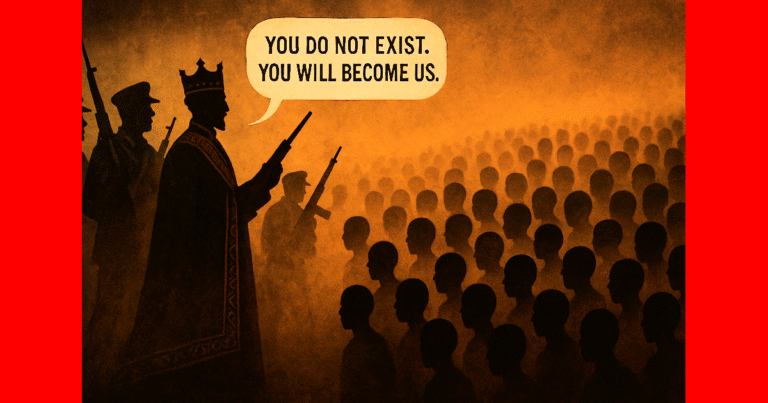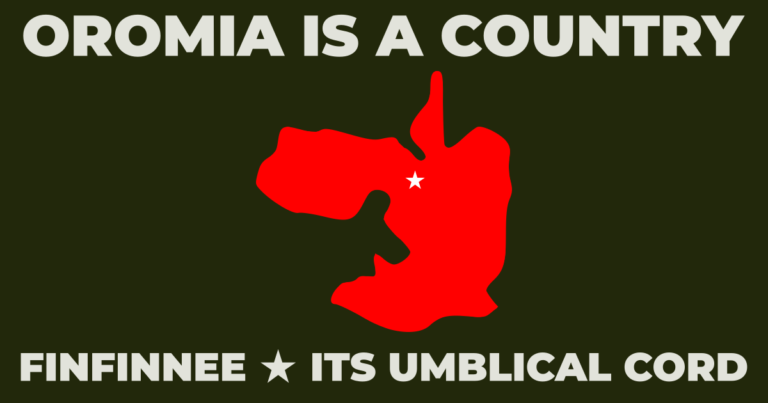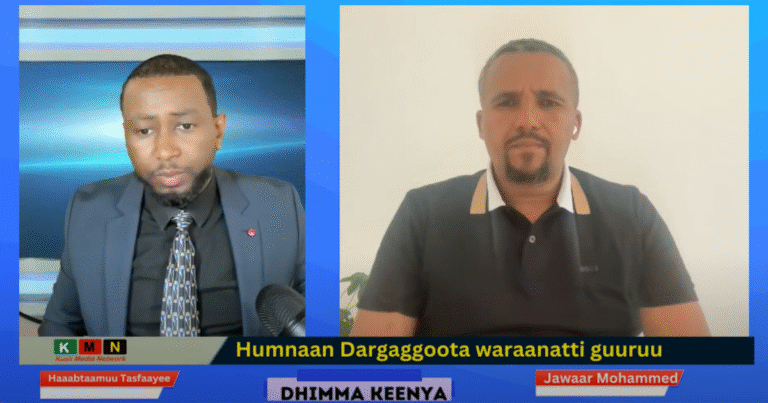Although no official region-based corruption index for comparison exists, based on the general sentiments of public outcry, Oromia is one of the most corrupt regions of Ethiopia, if not at the top of the league table. From minor traffic offences that can be settled by offenders for mere 100 to 200 Birr on-the-spot bribe, town municipality officers demanding upwards of about 50,000 Birr to sign off legitimate transfer of real estate ownership (from a seller to a buyer or upon inheritance), to multi-million corrupt commercial deals and kickbacks—the list is long and wide-ranging.
Almost Everybody Experiences Corruption!
With corruption so rife and nothing in place to discourage it, let alone attempt to eradicate it, in local offices such as “araddaas” or “gandaas”, bribes are openly traded to get that prompt attention because simple matters can otherwise take several days. This could be for a number of reasons, such as: “mysteriously missing files” that suddenly reappear after bribery; real or imagined outages of electricity or network; or the endless staff meetings that can prolong the process. One of our researchers has witnessed a gentleman openly throwing 200 Birr note at a clerk lady processing some applications whereupon her audible response was “…is this for my lunch?” as if to educate the crowd waiting for their turn.
Another researcher witnessed where officials at farming community’s fertilizer distribution centre were openly demanding up to 500 Birr per quintal (100 kg) fertilizer as a “subsidy for his workers” loading and unloading of fertiliser sacks. Of course, this is one of those corrupt extortions, but farmers are told as if this is an official directive from above and with no other alternative to get the fertilizer desperately needed for the cultivation season—an essential product that is becoming increasingly scarce and expensive like many import items over the recent past. Such on-the-side mini extortions are over and above the extortionately inflated prices already hurting farmers and indeed what prompted us to write this piece as we describe below.
In above, we are simply citing what are low-level and commonplace just to highlight to what extent ordinary people are desensitized. Indeed, indications are that there seem to be no shame in corrupt acts on both sides. This being one end of the spectrum, we are not even pretending to pick a typical example of the so serious bribery in the commercial arena, where millions of Birr are changing hands; or where officers in government authorities like the land management, the inland revenue, the police force, and even the judiciary, just to mention a few, employ well-coordinated extortions and blackmails for their corrupt ends.
For the Very Few, Corruption is Prosperity!
Corruptions come in subtle forms as influence peddling, favouritism, nepotism and clientelism and so on. Transparency International defines corruption as the abuse of entrusted power for private gain. Corruption is a cause of poverty and by its very nature—of entrusted power turning on itself as untrusted—it is a barrier to its eradication. The relationship between the act of corrupting and the state of poverty is numerous and common. As Negin et al., 2010, put in their data-based analysis, in the public sector, for example, corruption discourages growth and deepens poverty, weakening institutions. Corruption erodes the trust the public have in their public sector institutions, because public sector employees that are driven by greed act in their best personal interests rather than in the best interests of the public. Where the trust is eroded, the true meaning of government for the people will be lost as for numerous corrupt countries around the world.
In his recent video podcasts, an Ethiopian parliamentarian, Dr Angassa Ibrahim, exposed the deep-rooted corruption by top officials in the regional administration of Oromia. The nature of corruption is based on covert networking whereby influential politicians are paid big sums of money for influencing and facilitating lucrative businesses through their public offices. This form of bribery is what is referred to as Influence Peddling where the beneficiary is not a direct participant of a corrupt deal or business. As Dr Ibrahim cites, the most talked about in Oromia involves the distribution of consumer commodities, construction materials, agricultural produces, and industrial products that are in high demand—notable ones being construction materials such as cement, consumer products such as cooking oil, and the stimulant khat or “caat” that is widely used in Northeast Africa and the Arabian Peninsula. Likewise, import and domestic sale of agricultural machineries such as tractors and many other industrial products are part of the corrupt schemes.
… the Oromo farmers, forever, are attached to their land—more like an umbilical cord. Unless comprehensive safety net with proper training is in place, detaching that link would be like a grave delict and should be regarded as a canonical crime. This is where the EPRDF government had failed the Oromo farmers.
What Corruption Means to Farmers
Of all sectors of the society, farmers are the ones getting a raw deal by bearing the brunt of corruption at different levels. It is worth remarking that it is the agricultural produces of farmers that underpin a significant portion of country’s GDP at around 40%. Yet, farmers are the most impoverished in the society and, as rural dwellers, with non-existent basic services. In sharp contrast, farmers in the developed countries enjoy standard quality of life with agricultural subsidies being almost the norm to maintain it.
This last winter the retail price of fertilizer per quintal soared to nearly 5000 Birr compared to just over 1000 Birr the previous winter—an increase of up to 300%. As a result, some farmers were unable to raise money for fertilizers and they had, as a last resort, plant crops without fertilizer (a less profitable option as the yield would be greatly reduced), or lease out their farm plots on the cheap. We also got report of cases were some farmers were compelled to sell part of their plots to external bidders—in effect creating a new phenomenon that may lead to compelled self-eviction. It is possible that some of the farm plots were left without planting crops even after cultivating. This dire situation was mainly blamed on the Russia-Ukraine war for disrupting the supply chain for fertilizer, which was also previously impacted with reduced production due to the global COVID-19 pandemic. Experts also point to Ethiopia’s own two-year war in the North that has dissipated the dollar reserves which has made imports so expensive.
Farmers deserve massive life support in the form of agricultural subsidies. At the very least, essential imported agricultural inputs such as fertilisers and herbicides should be passed on to farmers at around the import cost price. The big question that needs to be addressed is that why farmers are subjected to retail prices, when the cost price for import is more appropriate, due to the fact that agricultural inputs like fertilizer are in the value-adding chain of the farm produce. To our surprise, we found out that there are private traders who are granted license to import and distribute fertilizers to farmers at huge profits. Why is such profiteering allowed on poor farmers with prices soaring when, in fact, subsidized prices are more appropriate? Who are really making the exorbitant profits from fertilizers at the expense of impoverishing farmers? Could the fertilizer import and distribution market, too, be part of the corrupt scheme as for the aforementioned items like cement and cooking oil?
If you’ve heard of the news about Ethiopia being on intent to export wheat starting from this spring harvest (end of 2022) and of irrigation-based summer harvest (around Q2 of 2023), then, wait for the double whammy about to hit our poor farmers. To what extent Ethiopia has the capacity to export wheat when so much is needed to feed so many needy people is a different question, but if look into how a greed-driven corrupt schemes work, it will all start to make sense.
We just found out that a price cap of 3200 Birr per quintal wheat is now in effect in Oromia. The scheme in place is for local cooperatives to buy from farmers at the capped price and sell to designated exporters at more than 6000 Birr per quintal. The question is, who is the beneficiary of such a big profit margin? On a historical note, the price fixing and market monopoly is reminiscent of the Derg era Ethiopian Grain Marketing Corporation that deprived farmers access to a free market.
It is quite astonishing when farmers are not allowed to sell their produce at a free market, particularly when they need to recoup their very high cost that includes expensive fertilizers, herbicides and in some cases rental of farming and harvesting machines. Contrary to the situation in Oromia, we can confirm that a quintal of wheat in SNNR region is sold for around 7000 Birr, which is more than double Oromia’s price cap at around 120%. This is absolute madness!
Corruption is Killing Oromia Farmers!
Corruption killing Oromia farmers is not a hyperbole; this has been happening, literally, since the days of the land grab policy of the EPRDF government on the pretext of investments. There are now credible evidences of increased mortality of farmers and their family members who had been evicted from their ancestral lands around Finfinnee (in Galaan, Laga Xaafo, etc). Disruption of life with eviction for many had often led to unfamiliar lifestyle with consequential ill-health and sudden onset of abject poverty. Compounded with this is a high suicide rate linked to disrupted life that is often underreported.
The fact is that one can lose cash compensation overnight, but the land plot is a tangible and immovable asset that provides lifetime guaranteed means of income and peace of mind. The corrupt land grab system never gave due consideration to this crucial point, and as a result, hundreds of thousands of Oromos fell victim of the land grab menace that is still in motion.
Politicians behind the land grab policy would want you to believe that evicted farmers had been paid generous compensation. While, for a start, we don’t believe for this to be true, it is also grossly irresponsible to expect farmers to be competent financial investors so as to live off earnings from their compensation package investments. In a country where corruption is one of the great menaces, it’s almost a sure thing to fall prey to corrupt people and end up in a sudden poverty. The fact is that one can lose cash compensation overnight, but the land plot is a tangible and immovable asset that provides lifetime guaranteed means of income and peace of mind. The corrupt land grab system never gave due consideration to this crucial point, and as a result, hundreds of thousands of Oromos fell victim of the land grab menace that is still in motion.
Understanding the underlying culture makes it clear that the Oromo farmers, forever, are attached to their land—more like an umbilical cord. Unless comprehensive safety net with proper training is in place, detaching that link would be like a grave delict and should be regarded as a canonical crime. This is where the EPRDF government had failed the Oromo farmers.
On the top of devastations by the EPRDF government, the Prosperity Party government has been engaging in multipronged corrupt schemes including wheat harvest price cap which can only be described as an antithesis of farmers’ predicaments—the soaring prices for fertilizers and related products; rapidly rising inflation for cost of living; the deep-rooted poverty arising from land grab and farmer population increase; and yes, all these wrapped as the total sum of all corruptions that cripple growth and deepen poverty even further.
While we consider corruption is generally a very serious concern, we believe that our farmers, most of whom live at or below the breadline, are in fact the direct victims of this menace. When farmers are denied of the right to recoup their cost of agricultural inputs in a free market, what hope is there for them? When local cooperatives compel farmers to sell wheat at 3200 Birr per quintal and sell the same to designated exporters at more than 6000 Birr, who really are the beneficiaries? What is the fate of the ever-increasing number of farmers that undoubtedly won’t afford the cost of agricultural inputs?
Is this to be a new form of land grab, albeit an indirect one, since the net effect of this will undoubtedly result in the surrender of farmlands with a systematic pricing out of farmers? Who will replace as impoverished farmers are forced off their lands?
These are the question we shall ponder and try to get answers to. The key to these questions and hopefully answers, in the first instance, is public awareness of the dire situation our farmers are subjected to. As the saying goes, a problem well understood is a problem half solved.
Campaign to Save our Farmers
At OROMIA TODAY we’ve decided to feature a permanent theme on Corruption so as to cover this important topic from time to time. We have added a category or tag “corruption” to our indexing so as to facilitate the search of articles on the topic.
And, that is not all. With this article, we are launching a hashtag campaign under the name #CorruptionKillsOromiaFarmers.
So, please do your part to spread the campaign by sharing on the social media, most importantly on Twitter and Facebook. If you can author an article on a related theme, we’ll gratefully consider your submission and please reach out at our email contact@oromia.today. Likewise, if you have any pertinent information to share regarding the endemic corruption in Oromia, please reach out to us.
Thank you.







